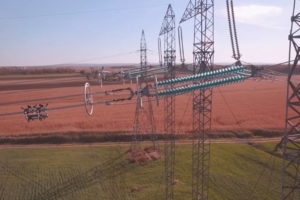
There are a growing number of inspection robots from bridge inspectors to ones used in agriculture to keep tabs on large numbers of crops. A new robot with the brilliant name “the LineRanger” has a different area of expertise, however: Inspecting power lines.
Created by the Montreal-based company Hydro-Québec, the LineRanger is a newly unveiled functional prototype for a robot designed to inspect the conductor bundles on high-voltage transmission lines. It is the first such robot to be designed with this task in mind. To carry its inspection out, it attaches to the power line and then uses a smart mechanism to essentially “hop” any obstacles it encounters by momentarily decoupling its connections.
It is able to work quickly and can cover around 12 miles of line every day, operating on a live line, which means that it doesn’t need to interfere with power transmission. As it is making its inspection rounds, the LineRanger can record video footage of any potential damage on the lines and send this information to a ground crew who can then arrange to have the line fixed.
This isn’t the only technology that Hydro-Québec has created for the task of transmission line inspection and maintenance. It previously developed a drone for the non-destructive evaluation of power transmission systems. The company’s drone is equipped with a smart sensor that is able to detect the earliest signs of corrosion in conductors. It’s also able to land on a live wire without causing damage to the drone or wire itself. Unlike the drone, however, the LineRanger doesn’t have the same challenges regarding short battery life. That means that it could be deployed as a more in-depth inspector able to travel along large lengths of line spotting damage.
There is no word from Hydro-Québec on when the technology is being rolled out, or whether any companies or states have adopted it yet. Considering the possible risk of a human getting too near to power lines, however, we have to say that this is one dangerous job that we’re more than happy to hand over to the machines — especially one that looks as ingenious as this.


